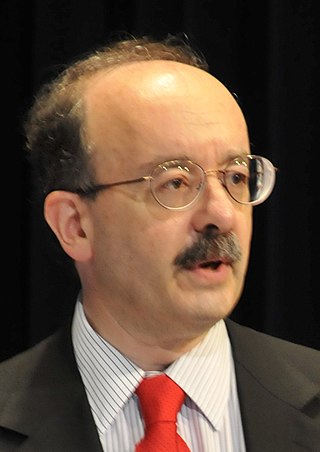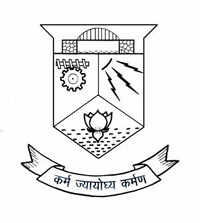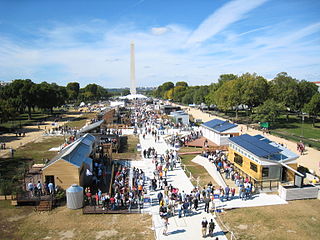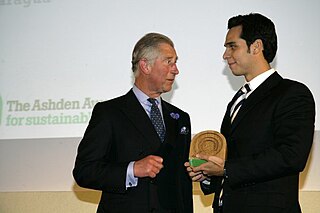
Amory Bloch Lovins is an American writer, physicist, and former chairman/chief scientist of the Rocky Mountain Institute. He has written on energy policy and related areas for four decades, and served on the US National Petroleum Council, an oil industry lobbying group, from 2011 to 2018.

New Mexico State University is a public land-grant research university in Las Cruces, New Mexico. Founded in 1888, it is the state's oldest public institution of higher education, and the state's first land-grant institution in New Mexico. NMSU has campuses in Alamogordo, Doña Ana County, and Grants, as well as research centers and programs in all 33 counties in the state.

Ecological engineering uses ecology and engineering to predict, design, construct or restore, and manage ecosystems that integrate "human society with its natural environment for the benefit of both".

The College of Engineering, Thiruvananthapuram, commonly shortened to CET, is an engineering college in the Indian state of Kerala, situated in Thiruvananthapuram. Founded in 1939 by the Travancore monarch Chithira Thirunal, it is the state's oldest technical institution. It currently offers undergraduate, graduate and research programs in eight branches of engineering and has been affiliated to the APJ Abdul Kalam Technological University since 2015, prior to which it was part of the University of Kerala.

Ramaiah Institute of Technology (RIT), formerly known as M.S. Ramaiah Institute of Technology (MSRIT), is an autonomous private engineering institute located in Bengaluru in the Indian state of Karnataka. Established in 1962, the college is affiliated to Visvesvaraya Technological University.

The Regeneron International Science and Engineering Fair (ISEF) is an annual science fair in the United States. It is owned and administered by the Society for Science, a 501(c)(3) non-profit organization based in Washington, D.C. Each May, more than 1800 students from roughly 75 countries and territories compete in the fair for scholarships, tuition grants, internships, scientific field trips and the grand prizes, including one $75,000 and two $50,000 college scholarships. All prizes together amount to over $8,000,000. Two major awards ceremonies are the Special Awards Organization Presentation and the Grand Awards Ceremony. The International Science and Engineering Fair was founded in 1950 by Science Service and was sponsored by Intel from 1997 to 2019. Regeneron Pharmaceuticals became the title sponsor for ISEF in 2020, but the event was cancelled that year and replaced with an online version due to the COVID-19 pandemic. The 2021 ISEF was a fully virtual event while 2022 was held online and in-person in Atlanta, GA, and 2023 was in person in Dallas, TX. The 2024 ISEF was held in person in Los Angeles, CA. The 2025 ISEF will be held in Columbus, OH.

Rajiv Gandhi Institute of Technology (RIT) is a state-government-owned engineering college in the Indian state of Kerala, located 14 km away from Kottayam. The college was founded in 1991 by the Government of Kerala, and has been affiliated with the APJ Abdul Kalam Technological University since the latter was founded in 2015.

The U.S. Department of Energy (DOE) Solar Decathlon is a collegiate competition, comprising 10 contests, that challenges student teams to design and build highly efficient and innovative buildings powered by renewable energy. The winners are selected based for the best blending of design architectural and engineering excellence with innovation, market potential, building efficiency, and smart energy production. In the summer of 2018, DOE merged its two student building design competitions into one Solar Decathlon competition.

Ashden is a London-based charity that works in the field of sustainable energy and development. Its work includes the annual Ashden Awards, advocacy and research in the field of sustainable energy, and mentoring and practical support for award winners.

A Zero-Energy Building (ZEB), also known as a Net Zero-Energy (NZE) building, is a building with net zero energy consumption, meaning the total amount of energy used by the building on an annual basis is equal to the amount of renewable energy created on the site or in other definitions by renewable energy sources offsite, using technology such as heat pumps, high efficiency windows and insulation, and solar panels.
Canadian Association of Physicists (CAP), or in French Association canadienne des physiciens et physiciennes (ACP) is a Canadian professional society that focuses on creating awareness among Canadians and Canadian legislators of physics issues, sponsoring physics related events, physics outreach, and publishes Physics in Canada. It was founded in July 1945. The organization has over 1,600 members and is bilingual, functioning in English and French.

Sustainable engineering is the process of designing or operating systems such that they use energy and resources sustainably, in other words, at a rate that does not compromise the natural environment, or the ability of future generations to meet their own needs.

Government Engineering College, Kozhikode (GECK), is a public engineering institute established by the Department of Technical Education under the Government of Kerala in India. It was one of the five public engineering institutes sanctioned in 1999 by the Government of Kerala. It is one of the 138 institutes affiliated to the APJ Abdul Kalam Technological University since 2015.
The Eni Award is a prize awarded by the Italian oil and gas company Eni with the aim of encouraging better use of energy sources and increased environmental research. The strict award guidelines and the notable names on the selection committee make Eni a coveted award. List of Eni award winners include Nobel laureates like Harold W. Kroto and Alan Heeger.
Environmentally sustainable design is the philosophy of designing physical objects, the built environment, and services to comply with the principles of ecological sustainability and also aimed at improving the health and comfort of occupants in a building. Sustainable design seeks to reduce negative impacts on the environment, the health and well-being of building occupants, thereby improving building performance. The basic objectives of sustainability are to reduce the consumption of non-renewable resources, minimize waste, and create healthy, productive environments.
North American collegiate sustainability programs are institutions of higher education in the United States, Mexico, and Canada that have majors and/or minors dedicated to the subject of sustainability. Sustainability as a major and minor is spreading to more and more colleges as the need for humanity to adopt a more sustainable lifestyle becomes increasingly apparent with the onset of global warming. The majors and minors listed here cover a wide array of sustainability aspects from business to construction to agriculture to simply the study of sustainability itself.
Environ was a privately held, international environmental, safety and health sciences consulting firm headquartered in Arlington, Virginia. ENVIRON had operations across more than 90 offices in 21 countries, with more than 1,500 consultants when it was acquired in December 2014 by Danish-based Ramboll.
Retopia is an annual technical symposium of the Indian Department of Energy and Environment at the TERI School of Advanced Studies in New Delhi. Retopia refers to getting back to an ideal state or situation, derived from the word Utopia. The symposium provides a common platform to people from the government, academic institutions, industries, start-ups etc. to discuss clean energy prospects on environmental, technical, social and commercial lines. Retopia has witnessed participation from the Ministry of New and Renewable Energy, the World Bank, Tata Consultancy Services (TCS), the Bureau of Energy Efficiency, the Indian Energy Exchange, and Suzlon.

The Oregon Institute of Technology, Portland-Metro or Oregon Tech Portland-Metro, previously Oregon Tech Wilsonville, is a campus in Wilsonville, Oregon of the Oregon Institute of Technology, a public college in Oregon. It offers bachelor's and master's degrees in the fields of Clinical Laboratory Science and Paramedic Science in partnership with OHSU, and engineering, technology and management degrees in electrical and renewable energy engineering, electronics, embedded systems, manufacturing, mechanical, software engineering, computer science, information technology, operations management, and geomatics. Oregon Tech is also affiliated with the Oregon Manufacturing Innovation Center in Scappoose, Oregon.














